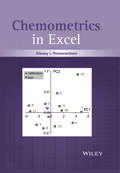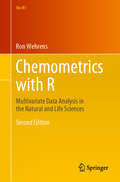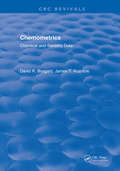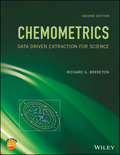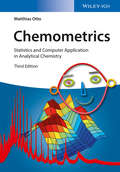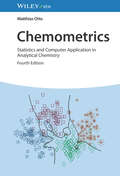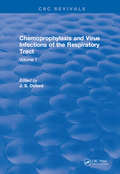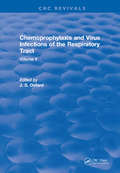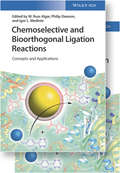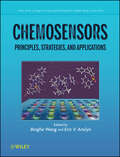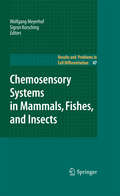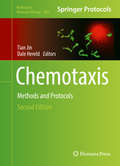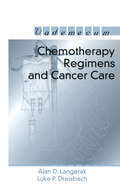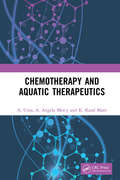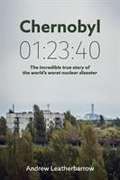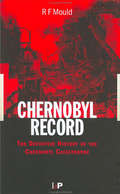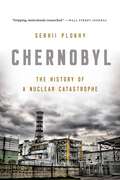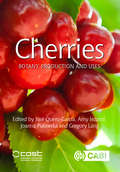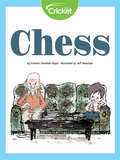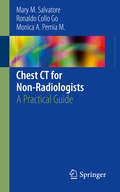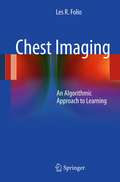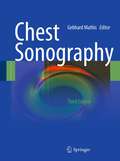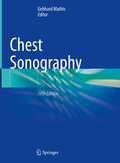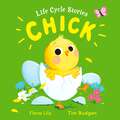- Table View
- List View
Chemometrics in Excel
by Alexey L. PomerantsevProviding an easy explanation of the fundamentals, methods, and applications of chemometrics* Acts as a practical guide to multivariate data analysis techniques* Explains the methods used in Chemometrics and teaches the reader to perform all relevant calculations* Presents the basic chemometric methods as worksheet functions in Excel* Includes Chemometrics Add In for download which uses Microsoft Excel® for chemometrics training* Online downloads includes workbooks with examples
Chemometrics with R: Multivariate Data Analysis in the Natural and Life Sciences (Use R!)
by Ron WehrensThis book offers readers an accessible introduction to the world of multivariate statistics in the life sciences, providing a comprehensive description of the general data analysis paradigm, from exploratory analysis (principal component analysis, self-organizing maps and clustering) to modeling (classification, regression) and validation (including variable selection). It also includes a special section discussing several more specific topics in the area of chemometrics, such as outlier detection, and biomarker identification. The corresponding R code is provided for all the examples in the book; and scripts, functions and data are available in a separate R package. This second revised edition features not only updates on many of the topics covered, but also several sections of new material (e.g., on handling missing values in PCA, multivariate process monitoring and batch correction).
Chemometrics: Chemical and Sensory Data
by David R. BurgardRanging from elegantly simple to extremely complex, a wide variety of flavors and fragrances stimulate our senses. It is difficult to understand the myriad sensory interactions involved because of the sheer complexity of their chemical composition. The aim of this text is to describe the use of chemometric techniques for understanding these complex systems and to serve as a practical guide to the acquisition, organization and reduction of chemical and sensory data. It explains chemical, sensory and multivariate analysis tools and their application. Pertinent concepts are discussed in-depth and are sufficiently illustrated with enough original data in complementary tables and figures to provide the basis for the execution of complex studies. The book emphasizes techniques that have been proven to work rather than those that "should" work from a theoretical standpoint. The book focuses on the acquisition of quality data and the subsequent interpretation of data rather than numerical computations used in data analysis. Chemometrics: Chemical and Sensory Data is an excellent resource for students and newcomers to flavor and fragrance research, as well as for experienced workers and product development managers.
Chemometrics: Data Driven Extraction for Science
by Richard G. BreretonA new, full-color, completely updated edition of the key practical guide to chemometrics This new edition of this practical guide on chemometrics, emphasizes the principles and applications behind the main ideas in the field using numerical and graphical examples, which can then be applied to a wide variety of problems in chemistry, biology, chemical engineering, and allied disciplines. Presented in full color, it features expansion of the principal component analysis, classification, multivariate evolutionary signal and statistical distributions sections, and new case studies in metabolomics, as well as extensive updates throughout. Aimed at the large number of users of chemometrics, it includes extensive worked problems and chapters explaining how to analyze datasets, in addition to updated descriptions of how to apply Excel and Matlab for chemometrics. Chemometrics: Data Driven Extraction for Science, Second Edition offers chapters covering: experimental design, signal processing, pattern recognition, calibration, and evolutionary data. The pattern recognition chapter from the first edition is divided into two separate ones: Principal Component Analysis/Cluster Analysis, and Classification. It also includes new descriptions of Alternating Least Squares (ALS) and Iterative Target Transformation Factor Analysis (ITTFA). Updated descriptions of wavelets and Bayesian methods are included. Includes updated chapters of the classic chemometric methods (e.g. experimental design, signal processing, etc.) Introduces metabolomics-type examples alongside those from analytical chemistry Features problems at the end of each chapter to illustrate the broad applicability of the methods in different fields Supplemented with data sets and solutions to the problems on a dedicated website Chemometrics: Data Driven Extraction for Science, Second Edition is recommended for post-graduate students of chemometrics as well as applied scientists (e.g. chemists, biochemists, engineers, statisticians) working in all areas of data analysis.
Chemometrics: Statistics and Computer Application in Analytical Chemistry
by Matthias OttoThe third edition of this long-selling introductory textbook and ready reference covers all pertinent topics, from basic statistics via modeling and databases right up to the latest regulatory issues. The experienced and internationally recognized author, Matthias Otto, introduces the statistical-mathematical evaluation of chemical measurements, especially analytical ones, going on to provide a modern approach to signal processing, designing and optimizing experiments, pattern recognition and classification, as well as modeling simple and nonlinear relationships. Analytical databases are equally covered as are applications of multiway analysis, artificial intelligence, fuzzy theory, neural networks, and genetic algorithms. The new edition has 10% new content to cover such recent developments as orthogonal signal correction and new data exchange formats, tree based classification and regression, independent component analysis, ensemble methods and neuro-fuzzy systems. It still retains, however, the proven features from previous editions: worked examples, questions and problems, additional information and brief explanations in the margin.
Chemometrics: Statistics and Computer Application in Analytical Chemistry
by Matthias OttoChemometrics Explore chemometrics from basic statistics to the latest artificial intelligence and neural network developments in this new edition Chemometrics is an area of study combining chemistry and mathematics. It governs the interpretation of data generated by chemical analysis, and its growth as a subfield promises to streamline and revolutionize analytical chemistry. Chemometrics has long been the leading introductory textbook in this subject. Beginning with an introduction to the statistical-mathematical evaluation of chemical measurements, it leads readers through modern chemometric approaches in a pedagogically sound and highly readable style. Now fully updated to reflect the latest research and applications of this exciting discipline, it provides essential tools for a new generation of analytical chemists. Readers of the fourth edition of Chemometrics will also find: New or expanded treatment of subjects such as deep learning, ANNOVA simultaneous component analysis, instrumental data output, and more Detailed discussion of approaches to signal processing, design and optimization of experiments, pattern recognition and classification, and many other areas Balance of theoretical and practical knowledge to enable rapid application of key techniques Chemometrics is ideal for advanced students in chemistry, analytical chemistry, pharmaceutical chemistry, biochemistry, or related subjects, and as a useful reference for practicing researchers and laboratory professionals.
Chemoprophylaxis and Virus Infections of the Respiratory Tract: Volume 1
by J.S. OxfordOriginally, it was our intention to produce a single-volume book covering all aspects and approaches to the problem of specific inhibitors of respiratory viruses. However, as the work progressed it became obvious that certain chapters, because of the research interests of the authors, concentrated particularly on influenza viruses. It seemed logical therefore, to divide the book into two volumes, the first emphasizing influenza and the second concentrating on other viruses as well as discussing important general aspects of drug screening and clinical testing, although the second volume does have some chapters which deal mainly with influenza.
Chemoprophylaxis and Virus Infections of the Respiratory Tract: Volume 2
by J.S. OxfordOriginally, it was our intention to produce a single-volume book covering all aspects and approaches to the problem of specific inhibitors of respiratory viruses. However, as the work progressed it became obvious that certain chapters, because of the research interests of the authors, concentrated particularly on influenza viruses. It seemed logical therefore, to divide the book into two volumes, the first emphasizing influenza and the second concentrating on other viruses as well as discussing important general aspects of drug screening and clinical testing, although the second volume does have some chapters which deal mainly with influenza.
Chemoselective and Bioorthogonal Ligation Reactions: Concepts and Applications
by Igor L. Medintz Philip Dawson W. Russ AlgarThis timely, one-stop reference is the first on an emerging and interdisciplinary topic. Covering both established and recently developed ligation chemistries, the book is divided into two didactic parts: a section that focuses on the details of bioorthogonal and chemoselective ligation reactions at the level of fundamental organic chemistry, and a section that focuses on applications, particularly in the areas of chemical biology, biomaterials, and bioanalysis, highlighting the capabilities and benefits of the ligation reactions. With chapters authored by outstanding scientists who range from trailblazers in the field to young and emerging leaders, this book on a highly interdisciplinary topic will be of great interest for biochemists, biologists, materials scientists, pharmaceutical chemists, organic chemists, and many others.
Chemosensors: Principles, Strategies, and Applications (Wiley Series in Drug Discovery and Development #15)
by Binghe Wang Eric V. AnslynA thorough, accessible, and general overview of chemosensors Providing a comprehensive overview of chemosensors—organic molecules designed to bind and sense small molecules or metal ions—and their applications, Chemosensors: Principles, Strategies, and Applications is an accessible one-stop resource for analysts, clinicians, and graduate students studying advanced chemistry and chemosensing. Chemosensors function on a molecular level, generating a signal upon binding. The book reviews their synthesis, design, and applications for detecting biological and organic molecules as well as metal ions. The text highlights applications in drug discovery and catalyses that have not been well covered elsewhere. Covering such topics as molecular recognition, detection methods, design strategies, and important biological issues, the book is broken into four sections that examine intermolecular interactions, strategies in sensor design, detection methods, and case studies in metal, saccharide, and amino acid sensing. An indispensable source of information for chemical and biomedical experts using sensors, Chemosensors includes case studies to make the material both accessible and understandable to chemists of all backgrounds.
Chemosensory Systems in Mammals, Fishes, and Insects (Results and Problems in Cell Differentiation #47)
by Wolfgang Meyerhof Sigrun KorschingThe sense of smell has varied roles in locating food, detecting predators, navigating, and communicating social information, whereas the taste system is focused on decision-making in food intake. The last decade has witnessed massive advances in understanding the molecular logic of chemosensory information processing, and the results for taste sensation were found to differ in interesting ways from those for smell sensation. The 12 chapters of this book cover the current knowledge about the chemosensory systems in mammalian, fish and insect models. The advantages of the different model systems are emphasized. The genomic characteristics and evolution of olfactory and gustatory receptor gene families are analyzed, rules for odorant receptor gene choice and axonal projection of the corresponding receptor neurons are discussed, and the similarities and dissimilarities of pheromone vs. odorant sensing are examined as well as the molecular logic of mammalian sweet taste, bitter taste, and fat perception. Olfactory-guided and taste-guided behaviors are discussed, with a particular emphasis on the insect system.
Chemotaxis: Methods and Protocols (Methods in Molecular Biology #1407)
by Tian Jin Dale HereldFundamental to the development and vital functions of organisms, the migration of motile cells due to the detection of shallow gradients of specific chemical signals in their environments, or chemotaxis, can be clearly seen as a major force in cell biology. In Chemotaxis: Methods and Protocols, expert researchers in the field provide state-of-the-art methods for investigating cell migration behaviors, studying molecular components involved in detecting extracellular signals and directing cell movement, visualizing spatiotemporal dynamics of the components in signaling networks of chemotaxis in real time, and constructing quantitative models that simulate chemoattractant-induced cell responses. Written in the highly successful Methods in Molecular BiologyTM series format, chapters include introductions to their respective topics, lists of the necessary materials and reagents, step-by-step, readily reproducible laboratory protocols, and notes on troubleshooting and avoiding known pitfalls. Comprehensive and cutting-edge, Chemotaxis: Methods and Protocols serves scientists with practical guidance on the diverse methodologies that are currently propelling chemotaxis research forward in order to further our understanding of this vital biological system.
Chemotherapy Regimens and Cancer Care
by Alan D. Langerak Luke P. DreisbachThis handbook is a concise, thorough, and portable reference guide to the multitude of complex chemotherapy protocols and other frequently utilized medications in the field of Hematology/Oncology. Its inclusion of commonly used oncology regimens, guidelines for supportive care during administration and sections on pain control, antibiotic use and a
Chemotherapy and Aquatic Therapeutics
by A. Uma A. Angela Mercy K. Karal MarxThis book deals with different kinds of chemotherapeutants that can be used in the treatment of diseases affecting fish. The mechanism of action behind every therapeutic agent is explained clearly for a better understanding of the basics of the drugs. Effective treatment would be achieved by proper delivery of the compounds at the right time. Different drug delivery methods to be practiced on farm are also deliberated in detail. This book will be immensely helpful to the fisheries students at the undergraduate and post graduate level and scholars pursuing research in the area of aquatic animal health management.Note: T& F does not sell or distribute the Hardback in India, Pakistan, Nepal, Bhutan, Bangladesh and Sri Lanka.
Chernobyl 01: The Incredible True Story Of The World's Worst Nuclear Disaster
by Andrew Leatherbarrow Elizabeth PetreyAt 01:23:40 on April 26th 1986, Alexander Akimov pressed the emergency shutdown button at Chernobyl's fourth nuclear reactor. It was an act that forced the permanent evacuation of a city, killed thousands and crippled the Soviet Union. The event spawned decades of conflicting, exaggerated and inaccurate stories. <p><p> This book, the result of five years of research, presents an accessible but comprehensive account of what really happened. From the desperate fight to prevent a burning reactor core from irradiating eastern Europe, to the self-sacrifice of the heroic men who entered fields of radiation so strong that machines wouldn't work, to the surprising truth about the legendary 'Chernobyl divers', all the way through to the USSR's final show-trial. The historical narrative is interwoven with a story of the author's own spontaneous journey to Ukraine's still-abandoned city of Pripyat and the wider Chernobyl Zone. <p> Complete with over 45 pages of photographs of modern-day Pripyat and technical diagrams of the power station, Chernobyl 01:23:40 is a fascinating new account of the world's worst nuclear disaster.
Chernobyl Record: The Definitive History of the Chernobyl Catastrophe
by R.F MouldThe nuclear accident at Chernobyl on April 26, 1986 had a heavy impact on life, health, and the environment. It caused agony to people in the Ukraine, Belarus, and Russia and anxiety far away from these countries. The economic losses and social dislocation were severe in a region already under strain. It is now possible to make more accurate assess
Chernobyl: The History of a Nuclear Catastrophe
by Serhii PlokhyFrom a preeminent historian of Eastern Europe, the definitive history of the Chernobyl nuclear disaster On the morning of April 26, 1986, Europe witnessed the worst nuclear disaster in history: the explosion of a reactor at the Chernobyl Nuclear Power Plant in Soviet Ukraine. Dozens died of radiation poisoning, fallout contaminated half the continent, and thousands fell ill. In Chernobyl, Serhii Plokhy draws on new sources to tell the dramatic stories of the firefighters, scientists, and soldiers who heroically extinguished the nuclear inferno. He lays bare the flaws of the Soviet nuclear industry, tracing the disaster to the authoritarian character of Communist party rule, the regime's control of scientific information, and its emphasis on economic development over all else. Today, the risk of another Chernobyl looms in the mismanagement of nuclear power in the developing world. A moving and definitive account, Chernobyl is also an urgent call to action.
Cherries: Botany, Production and Uses (Botany, Production and Uses)
by Yan Wang Amy Iezzoni Gregory Lang Matthew Whiting Marlene Ayala Teresa Barreneche Tim Beliën Michael Blanke Jorunn Børve Donato Boscia Geza Bujdoso José Antonio Campoy Thierry Candresse Gerard Charlot Sezai Ercisli Ricardo Flores Thomas Forge Milica Fotiric Akšic Michael Gétaz Daniela Giovannini David Gónzalez-Gómez Maria Herrero Monika Höfer Károly Hrotkó Jovana Hrustic Antonio Ippolito Delano James Wihelm Jelkmann Martin Jensen Monika Kaluzna Moritz Knoche Kirsten Koppler Kouman Koumanov Nemanja Kuzmanovic Lynn Long Gregorio López-Ortega Slawomir A Lux George Athanasios Manganaris Marta Mari Mekjell Meland Monika Michalecka Dragan Milatovic Denise Neilsen Gerry Neilsen Aleksa Obradovic László Palkovics Vicente Pallás Nikolaos T Papadopoulos Janos Apostol Gérard Charlot Miroslawa Cieslinska James Delano Kirsten Köppler Slawomir A. Lux Vicente Pallas Nikolaos T. Papadopoulos Ronald Perry Anna Poniatowska Joël F. Pothier Joanna Pulawska Javier Rodrigo José Quero-García Elzbieta Rozpara Michela Ruinelli Simona Marianna Sanzani Maria Saponari Mirko Schuster Manuel Joaquín Serradilla Brankica Tanovic Peter Toivonen Daniel Valero Anita Végh Aleš Vokurka Bénédicte Wenden Andreas Winkler Ana Wünsch Juan Pablo ZoffoliSweet and sour cherries (Prunus avium and Prunus cerasus) are important fruit crops for which demand is high and growing. A significant number of new varieties, rootstocks and training systems have been released or developed in recent years in order to improve the efficiency and profitability of cherry orchards. Cherries: Botany, Production and Uses covers the genetics, ecophysiology, production, protection and uses of cherries. Presenting up-to-date scientific data and applied information, this book is invaluable for researchers, teachers and all professionals working in the cherries value chain.
Chesapeake Bay Walk
by David Owen BellFrom the Book Jacket: What Awesome Chesapeake does for older children, this book will do for youngsters ages four to nine-awaken them to the wonders of the Chesapeake Bay and the life in and around it. Written by the same author, Chesapeake Bay Walk takes young children and their parents or teachers on an unforgettable shoreline journey. On a stroll through its pages, they can find soft-bellied bullies, birds once hunted for their feathers, crabs older than dinosaurs, "bald" five-year-olds, and living prehistoric creatures made of water. David Owen Bell, author of Awesome Chesapeake and Chesapeake Bay Walk, has been involved in children's outdoor education for many years. Jennifer Heyd Wharton, a watercolorist, has also illustrated four children's books.
Chess
by Amy TaoJoey is not excited to spend an afternoon with his grandfather. He is always sad and doesn’t seem to like Joey all that much. After struggling to find something to do together, Joey finds an old chess set. His grandfather decides to teach him how to play chess. Will this game help Joey see his grandfather in a new light?
Chest CT for Non-Radiologists: A Practical Guide
by Mary M. Salvatore Ronaldo Collo Go Monica A. Pernia M.This book is a practical guide to chest CTs for non-radiologists. A succinct and focused book, Chest CT for Non-Radiologists is designed to give the reader just the level of information they need to know. Chapters begin with the basics of a chest CT, including when they are necessary and the basic procedures, so physicians and medical professionals can best counsel their patients. The book then moves into various parts of the chest and the common diseases and presentations that would be found in a chest CT (lung fibrosis, pulmonary nodules, etc.). It teaches the reader what to look for and how to provide the most accurate and effective diagnosis for their patients. There are also several de-identified CT scans that allow the reader to test his or her skills. This is an ideal resource for non-radiologist physicians -- including pulmonologists, internal medicine physicians, emergency medicine physicians, and critical care specialists, residents, and medical students -- to learn the basics of the chest CT and thereby provide optimal care for their patients.
Chest Imaging: An Algorithmic Approach to Learning
by Les R. FolioThe chest X-ray (CXR) or chest radiograph remains the most commonly ordered imaging study in medicine, yet paradoxically is often the most complex to learn, recall, and master effective and accurate interpretation. The chest radiograph includes all thoracic anatomy and provides a high yield, given the low cost and single source. This guide presents a structured lexicon for use by readers to reproducibly describe radiographic abnormalities of the chest detected on plain film CXRs. The lexicon is designed to provide readers with clinically significant differentiation of abnormalities detected. The content is structured to relate specific combinations of distinct radiographic findings to classes/groupings of pathological etiologies of those findings. Recognizing the individual findings and identifying their combination or lack of combination with other individual findings allows readers to create effective differential diagnoses that can then be further evaluated using other imaging procedures and/or non-radiographic clinical information. The book includes hundreds of images, including radiographs, CTs, graphics, and analogous models to help teach otherwise complex processes and radiographic principles.
Chest Sonography
by Gebhard MathisChest sonography is an established procedure in the assessment of pulmonary and pleural disease, allowing the investigator to make an unequivocal diagnosis without exposing the patient to costly and stressful procedures. Since the second edition of this book, the value of chest sonography has been further demonstrated in many new studies, especially regarding the application of portable ultrasound stethoscope systems. The new edition presents the state of the art in chest investigation by means of ultrasonography and takes into account the results of the 1st International Consensus Conference on Pleural and Lung Ultrasound. The numerous excellent illustrations and the compact text provide concise and easy-to-assimilate information about the diagnostic procedure. Basic aspects such as indications, investigative techniques, and image artifacts are detailed in separate chapters, and new chapters have been included on emergency ultrasound of the chest and pediatric chest sonography.
Chest Sonography
by Gebhard MathisThis book, widely regarded as the standard work in the field, presents the state of the art in chest sonography, enhanced by a wealth of excellent illustrations. It provides the reader with concise, easy-to-assimilate information on all aspects of the use of the modality, including indications, investigative techniques, diagnostic decision making, and imaging artifacts and pitfalls. Chapters offer numerous tips and tricks and highlight potential diagnostic error sources to aid in daily clinical practice. This sixth edition has been extensively revised to consider the latest techniques, study results, and meta-analyses and includes essential additional illustrative material. Chapter revisions include detailed guidance on contrast-enhanced ultrasound (CEUS) and the use of thoracic point-of-care ultrasound (PoCUS) in emergency patients. As the technique's value and use continue to grow, readers will find Chest Sonography a valuable up-to-date resource and guide.
Chick (Life Cycle Stories #2)
by Flora LilyMeet Chick. Chick likes running around in the sunshine, squabbling with her sisters and pecking tasty treats with her pointy beak. And she loves to CLUCK CLUCK CLUCK.But Chick has a secret . . . Before she could do ANY of these things, she was just one of a dozen eggs nestled in the cosiest corner of the hen house. So how did that egg come to be Chick?Join Chick on an adorable adventure, full of facts about the different life stages of chicks - from egg to chick to pullet to hen - and watch the life cycle begin all over again.
